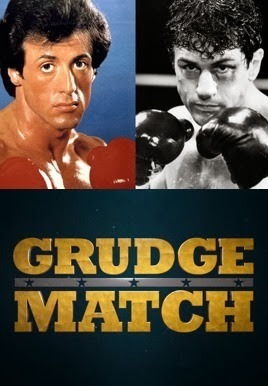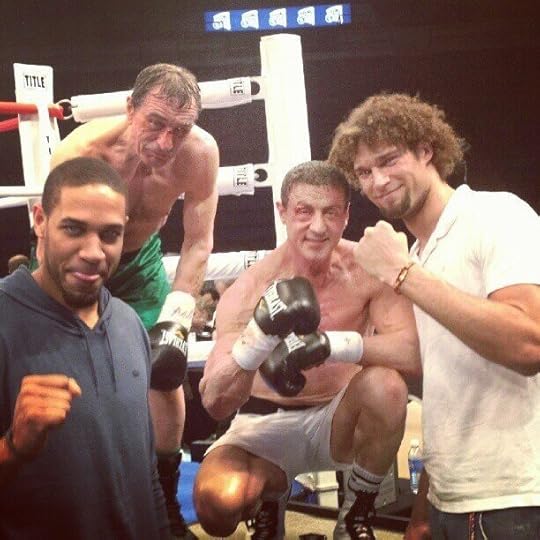Paul Bishop's Blog, page 62
October 8, 2013
HOW A VINTANGE FIGHT CARD NOVELLA WAS BORN IN THE CLOUD!
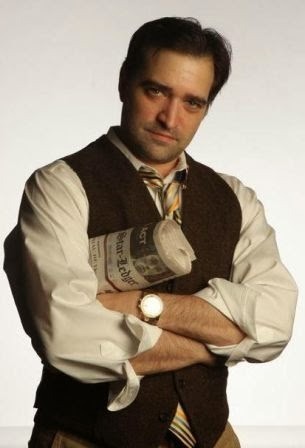 HOW A VINTANGE FIGHT CARD NOVELLA WAS BORN IN THE CLOUD!
HOW A VINTANGE FIGHT CARD NOVELLA WAS BORN IN THE CLOUD!ANTHONY VENUTOLO TELLS US ABOUT THE SURPRISING WRITING TECHNIQUES HE USED WHEN PUNCHING OUT FIGHT CARD: FRONT PAGE PALOOKA ...When Paul Bishop approached me at what now seems like an eternity ago to write a Fight Card entry, I was instantly on board. Fight Card was everything I loved – vintage pulp tales of tough guys and their femme fatales that were hard-boiled and whiskey-soaked. Sign me up.But then came the panic.Panic why? Unlike my fellow Fight Card scribes, I wasn't a novelist. Those said, I was a lifelong journalist and editor by trade and have even dabbled in many other forms of creative writing on the side. Through the years, I've written a slew of spec scripts for movies and comic books, a proposal and bible for an animated TV show (which was pitched around) and more magazine and newspaper pieces than I care to remember.But never a novel ...Sure, I dabbled in short stories, gritty poetry and flash fiction on my blog Bukowski's Basement, which I know Paul had read. To me, writing the weekly flash fiction noir was easy. Doing that for 30,000 plus words seemed daunting.What was even more petrifying was the prolific pace that other writers seemed to work. Guys like Bishop, Mel Odem, Eric Beetner, Terrence McCauley and Kevin Michaels all make it look so damned easy. I needed my wheels to spin like a '49 Merc.As far as my Fight Card entry as concerned, I kI also wanted to soak up what came before in the hard-boiled and noir arena. I was pleasantly shocked to see a plethora of full-length films available on YouTube and Netflix. Just a quick sampling of the flicks I was able to stream: Pickup on South Street, Call Northside 777, Sweet Smell of Success, Night and the City, Scandal Sheet, Sunset Blvd., The Strange Love of Martha Ivers, The Black Dahlia, Hollywoodland, Gilda, Tokyo Joe, Deadline USA, Panic in the Streets, House by the River, Woman in the Window, The Stranger, Witness to Murder, Hideout, The Naked City, Union Station, The Man Who Wasn't There, The Long Goodbye, My Gun is Quick, Kiss Me Deadly, Blonde Ice, While the City Sleeps, Borderline, Kiss of Death, The Prowler, The Night Editor, The Harder They Fall, The Big Caper, The Killing, The Asphalt Jungle, Double Indemnity, Kansas City Confidential, Where the Sidewalk Ends and Detour.It was time to start writing. Front Page Palooka (originally titled Union Of The Snakes) was written entirely in the cloud. Sure, a local copy was saved on my main laptop, but whenever I switched computers, it was waiting for me, no matter where I was. My primary service was Skydrive, with a backup on Google Drive and Dropbox. On days when I didn't feel like lugging out the laptop, the writing was done using the same services on my iPad and a great app called IA Writer.So, there … That’s how a vintage novella set in 1954 was born and bred using cloud services circa 2013. There are so many tools available for writers today to gain inspiration while putting the words down one after another ...
Published on October 08, 2013 15:07
HOW A FIGHT CARD NOVELLA WAS BORN IN THE CLOUD!
 HOW A VINTANGE FIGHT CARD NOVELLA WAS BORN IN THE CLOUD!
HOW A VINTANGE FIGHT CARD NOVELLA WAS BORN IN THE CLOUD!ANTHONY VENUTOLO TELLS US ABOUT THE SURPRISING WRITING TECHNIQUES HE USED WHEN PUNCHING OUT FIGHT CARD: FRONT PAGE PALOOKA ...When Paul Bishop approached me at what now seems like an eternity ago to write a Fight Card entry, I was instantly on board. Fight Card was everything I loved – vintage pulp tales of tough guys and their femme fatales that were hard-boiled and whiskey-soaked. Sign me up.But then came the panic.Panic why? Unlike my fellow Fight Card scribes, I wasn't a novelist. Those said, I was a lifelong journalist and editor by trade and have even dabbled in many other forms of creative writing on the side. Through the years, I've written a slew of spec scripts for movies and comic books, a proposal and bible for an animated TV show (which was pitched around) and more magazine and newspaper pieces than I care to remember.But never a novel ...Sure, I dabbled in short stories, gritty poetry and flash fiction on my blog Bukowski's Basement, which I know Paul had read. To me, writing the weekly flash fiction noir was easy. Doing that for 30,000 plus words seemed daunting.What was even more petrifying was the prolific pace that other writers seemed to work. Guys like Bishop, Mel Odem, Eric Beetner, Terrence McCauley and Kenneth Michaels all make it look so damned easy. I needed my wheels to spin like a '49 Merc.As far as my Fight Card entry as concerned, I kI also wanted to soak up what came before in the hard-boiled and noir arena. I was pleasantly shocked to see a plethora of full-length films available on YouTube and Netflix. Just a quick sampling of the flicks I was able to stream: Pickup on South Street, Call Northside 777, Sweet Smell of Success, Night and the City, Scandal Sheet, Sunset Blvd., The Strange Love of Martha Ivers, The Black Dahlia, Hollywoodland, Gilda, Tokyo Joe, Deadline USA, Panic in the Streets, House by the River, Woman in the Window, The Stranger, Witness to Murder, Hideout, The Naked City, Union Station, The Man Who Wasn't There, The Long Goodbye, My Gun is Quick, Kiss Me Deadly, Blonde Ice, While the City Sleeps, Borderline, Kiss of Death, The Prowler, The Night Editor, The Harder They Fall, The Big Caper, The Killing, The Asphalt Jungle, Double Indemnity, Kansas City Confidential, Where the Sidewalk Ends and Detour.It was time to start writing. Front Page Palooka (originally titled Union Of The Snakes) was written entirely in the cloud. Sure, a local copy was saved on my main laptop, but whenever I switched computers, it was waiting for me, no matter where I was. My primary service was Skydrive, with a backup on Google Drive and Dropbox. On days when I didn't feel like lugging out the laptop, the writing was done using the same services on my iPad and a great app called IA Writer.So, there … That’s how a vintage novella set in 1954 was born and bred using cloud services circa 2013. There are so many tools available for writers today to gain inspiration while putting the words down one after another ...
Published on October 08, 2013 09:04
PULP NOW: WRITE THE GOOD FIGHT!
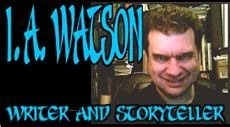 PULP NOW: WRITE THE GOOD FIGHT!
PULP NOW: WRITE THE GOOD FIGHT!British author I.A. Watson is a prolific adventure writer with his feet firmly planted in the New Pulp genre. His numerous stories published in collections from Pro Se’s Pulp Obscura imprint further the adventures of such pulp stawarts as air ace Richard Knight and adventurer Armless O’Neil, and his three Robin Hood novels published by Airship 27 are a tour-de-force ... Today he’s on Bish’s Beat talking about the writing of top-notch fight scenes – a subject near to the heart of all Fight Card fans ...
WRITE THE GOOD FIGHT
The fight is one of the staples of pulp fiction. Whether it’s two guys brawling it out in a ring, a life and death punch-up on the top of a speeding train, or a shoot-out showdown in the ruins of some alien civilisation, that action finish is the capper for a lot of stories, old and new. Writing fights is an important skill for anyone who wants to pen pulp stories or adventure stories in general, so here are some thoughts on what makes for a good on-paper punch-up.
VISUALS
It might seem strange to talk about images in a print medium, but it’s that lack of pictures that makes them all the more important. The author’s got to paint a picture in the reader’s mind. Do it well and its better than the best big budget blockbuster. Establish the scene. Show the terrain. Reference anything that’s going to be relevant in the fight to come. If someone’s going to get a bottle smashed over them then mention the bar. Make sure its clear who’s there: protagonist, antagonist, and onlookers. Paint in the details – and don’t forget sound, smell, and taste.
CHOREOGRAPHY
Real life can get away with things that fiction can’t. Story fights have to be mini-stories themselves, plotted so there’s a pace, continuity, developments, and a climax. There should be twists and turns, drama, shocks, horror, maybe even humour. If the fight is the climax of the story then it might be quite long, so changes of speed and an evolving conflict really matter.
There are all kinds of tricks for helping the story of the fight along. One is to have the fight interact with the environment. A duel in a blazing building or a free-for-all in a seedy waterfront bar will automatically interface background with the combat. Another way is to identify a problem that must be overcome to win the battle – the villain cheats, the big bad guy doesn’t even flinch when he gets hit, our hero has to get past the enemy to shut down the doomsday clock. Yet another is to run the fight through a character’s perspective, following his internal thoughts, feelings, and experiences as he struggles through.
DIALOGUE
It’s quite possible to do a great punch-up without any chatter, but unlike the real world, fictional characters are quite capable of holding a conversation as they beat nine kinds of hell out of each other. Dialogue allows for an automatic change of pace as hero and villain exchange threats, banter, trash talk, plot points. It can be a breather in the action, a way of narrating events, or even another form of combat. An enraged villain is a careless villain who might let his guard drop. An outraged hero might just go that bit further and make the supreme effort.
STYLE
Different heroes fight in different ways. Picking on a couple of pulp characters I’ve written for in Pro Se publications:
* Detective airman Richard Knight is in the gentleman hero category. When he’s taking someone on he’s an expert pugilist with scientific method. His sidekick, raucous ex-Marine Larry Doyle, is more of a slugger.
* African soldier of fortune adventurer for hire Armless O’Neil comes from a Bogart/African Queen background by way of Popeye the Sailor Man. He’s tough as nails. He’ll take his licking and still come back fighting ‘cause he’s too dumb and stubborn to lie down. Of special note with O’Neil is that one hand’s replaced with a wicked hook, which also makes for a different kind of brawl.
Clearly, to do justice to each combatant their fights need to reflect their character. In my Robin Hood novels, the bold outlaw swashbuckles and quips his Errol Flynn best. At the other end of the spectrum, the Spider is ruthless and terrifying when he enters combat. Good fights are driven by the nature of the adversaries. Really good fights can amplify and develop the characters themselves.
THE KNOCK-DOWN
A good fight has a good ending. It might be the main character’s final triumph as the villain topples into the volcano. It might be a nail-biting cliffhanger as the Nazis beat our hero unconscious. Combat might be interrupted as the whole spaceship lurches into the gravity well. At battle’s end we and the characters might feel exalted by victory, sickened by loss, exhausted by some supreme effort. The winner might have saved the day, got the girl, or lost everything. The last moments of the fight are vital to whatever happens next in the story, so they have to hit exactly the right notes to lead the reader on to the next narrative beat or to the story’s conclusion.
Fiction tales depend on conflict. Physical conflict is a big subset. Getting it right is hugely important in getting a pulp story to fly. Pulp tends to be stripped down, visceral stuff, designed to have an emotional as well as an intellectual impact. Fights go straight to that primal part of us that struggles to survive. Fights to save the damsel, rescue the baby, prevent disaster, prove oneself the best, all speak to deep elements of our psyche. Get that right and the readers follow.
Don’t underestimate the art of fight-writing.
I.A. Watson is a freelance writer operating out of Yorkshire, England. He’s authored four award-shortlisted novels and a whole load of short stories.
His work on classic airman detective Richard Knight appears in The New Adventures of Richard Knight, volume 1 (on sale now) and volume 2 (forthcoming), from Pro Se’s Pulp Obscura imprint.
His work on African adventurer Armless O Neil appears in Blood Price of the Missionary’s Gold: The New Adventures of Armless O’Neil, also from Pro Se’s Pulp Obscura imprint.
A volume of I.A Watson’s essays and comments, Where Stories Dwell, is currently in production.
TO VISIT HIS WEBSITE CLICK HERE
Published on October 08, 2013 08:14
October 7, 2013
FIGHT CARD ON DAVE WHITE PRESENTS!
 FIGHT CARD ON DAVE WHITE PRESENTS!
FIGHT CARD ON DAVE WHITE PRESENTS!Tomorrow night, Tuesday Oct. 8th, Fight Card creator Paul Bishop returns to Dave White Presents to discuss the series along with Carol Malone, author of the recently released Fight Card Romance: Ladies Night.
They'll discuss the content and flavor of the books along with how they're marketing the books differently on Amazon and then as snazzy paperbacks. You too can join the Fight Card universe, and we'll tell you how to jump in on a very rock 'em, sock 'em Dave White Presents!
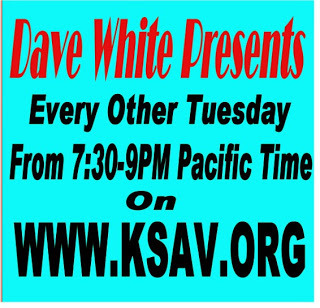 Put on your boxing gloves and join Paul and Carol on the next DAVE WHITE PRESENTS, Tuesday, Oct. 8 at 7:30 p.m. Eastern, then 7:30 Pacific over www.KSAV.org ...
Put on your boxing gloves and join Paul and Carol on the next DAVE WHITE PRESENTS, Tuesday, Oct. 8 at 7:30 p.m. Eastern, then 7:30 Pacific over www.KSAV.org ...
Published on October 07, 2013 11:47
October 5, 2013
GRUDGE MATCH – ROCKY VS. RAGING BULL!
Published on October 05, 2013 22:44
ROBERT E. HOWARD'S CORNER MEN
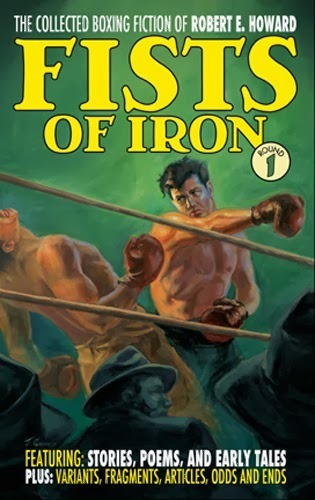 ROBERT E. HOWARD’S CORNER MEN
ROBERT E. HOWARD’S CORNER MENMARK FINN
The minute I stepped ashore from the Sea Girl, merchantman, I had a hunch that there would be trouble. This hunch was caused by seeing some of the crew of the Dauntless. The men on the Dauntless have disliked the Sea Girl’s crew ever since our skipper took their captain to a cleaning on the wharfs of Zanzibar – them being narrow-minded that way. They claimed that the old man had a knuckle-duster on his right, which is ridiculous and a dirty lie. He had it on his left. ~ Robert E. Howard, The Pit of the Serpent
Robert E. Howard is best-known for (some would say “forever saddled with”) the creation of Conan the Cimmerian, the invention of sword and sorcery, and also the weird western. These are laudable and important things, to be sure, but what very few people know is that Howard made a good living writing and selling boxing stories in the late 1920s and early 1930s. Primarily humorous in nature, Howard’s boxing stories featuring Sailor Steve Costigan were popular and in-demand by the publishers of Fight Stories, Action Stories, Sport Story, Jack Dempsey’s Fight Magazine, and others. They were critical to Howard’s development as a writer, both creatively and financially. And now, at long last, all of Howard’s boxing fiction is being collected into a massive, four-volume set of books published by the Robert E. Howard Foundation Press.
Iron Fists: The Collected Boxing Stories of Robert E. Howard, has been a labor of love for myself and fellow editors Chris Gruber and Patrice Louinet. We have been long time champions and defenders of these stories, for a number of reasons. First and foremost, they are about boxing – and I mean, deeply mired in the language and lore of the squared circle. Howard was an amateur boxer and an enthusiastic fan of the sport, and you can tell from the second you read one of his riveting prize-fight scenes. He really knew his stuff.
Second, these stories are funny. And I don’t mean a little bit, either. I have described Sailor Steve Costigan, the champion of the merchant marine Sea Girl, as having a heart of gold, fists of steel, and a head full of rocks. Costigan is a classic unreliable narrator, and these stories are all written in first person unreliable. The malapropisms and near-swearinvective, not to mention that Costigan is just not smart enough to do anything other than punch his way clear of trouble, makes these stories a joy to read.
Not all of the boxing stories are funny, though. Howard did write a number of more serious pieces exploring various aspects of what he considered made for a great boxer. One story, Iron Man, is a veritable saga that has only recently been restored to its original intended length.
So, if these stories are so great, how come you’re just hearing about them now? Great question. All I can tell you is, blame Conan. Most people are unaware of Howard’s massive output of humorous writing – over a hundred stories, including the funny boxing and his later funny western stories. Mostly because prior editors and stewards of Howard’s legacy felt it would be better to focus on Conan and the brooding young man who wrote those tales. Reading Howard’s humorous fiction casts a different light on the brooding loner who wrote of imaginary lands and strange monsters.
Over the past ten years, we’ve done what we could. I produced a series of old time radio plays featuring Sailor Steve Costigan. I wrote the introduction to Waterfront Fists, from Wildside Press. Chris Gruber edited and introduced Boxing Stories from the University of Nebraska Press. We pressured our friend Rusty Burke until he felt obliged (he insists it was convinced) to include boxing stories in the two volume Best of Robert E. Howard books from Del Rey.
All of those results brought more folks around to the boxing stories. We had new fans left and right. Sailor Steve Costigan began appearing in everyone’s list of Howard’s heroes when they were name checked. These were nice efforts, but it wasn’t enough, because there was so much boxing material that no one had ever seen, and it was languishing. Until now.
The project took a year to do, and it’s the first publication to make full use of the Glenn Lord archive. Multiple drafts were consulted, and extra pieces and parts were discovered. Now Iron Fists will contain literally every scrap of fiction, non-fiction, and poetry that Howard wrote about boxing in his lifetime. Patrice Louinet has painstakingly consulted every page of text to determine the order in which these stories were all written. His findings are published in a four part afterword. Gruber and I traded off on the introductions to the books. He got volumes 1 and 3. I got volumes 2 and 4. That way, we each get to talk about Steve Costigan, our favorite Howard hero. A few of the stories are now more complete, thanks to Patrice’s text corrections with the drafts that were discovered in the Glenn Lord archive. For completists, it’s your dream come true.
We couldn’t be more excited or proud. But Gruber and I aren’t stopping there. We have another project, related to the boxing stories, that I can’t tell you about right now. But suffice to say, it’ll be a unique and very relevant item that die-hard boxing fans won’t want to miss out on.
The foundation is currently offering the books as limited edition hardcovers. Depending on how fast they sell out, we may see trade paperbacks after that. For more information about the books, as well as a table of contents, you can visit the Foundation’s website here: http://www.rehfoundation.org/
Published on October 05, 2013 11:58
October 4, 2013
AVAILABLE NOW ~ FIGHT CARD: FRONT PAGE PALOOKA!
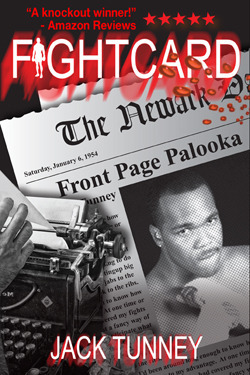
AVAILABLE NOW ~ FIGHT CARD: FRONT PAGE PALOOKA!
Newark, New Jersey, 1954
Years of fight halls and newsrooms have east coast sportswriter, Nick Moretti, looking for a change. When a sloppy hustle goes bad, and Nick takes a bullet in the shoulder, it’s time to go west. Hired by Pinnacle Pictures to write a boxing movie about troubled heavyweight champ Jericho ‘Rattlesnake’ McNeal, Nick joins forces with sexy public relations gal, Dillian Dawson, for a cross-country tour to give an everyman boxer an unlikely shot at the world title – what could go wrong?
From the crackling neon of Hollywood and Sin City, through the steamy Delta, and on to Chi-Town, the glitzy dream becomes a noir nightmare, and newshound Nick Moretti is about to commit a reporter’s greatest sin – becoming a Front Page Palooka ... Another great two-fisted Fight
Card tale!
Published on October 04, 2013 22:57
FIGHT CARD UPDATE!
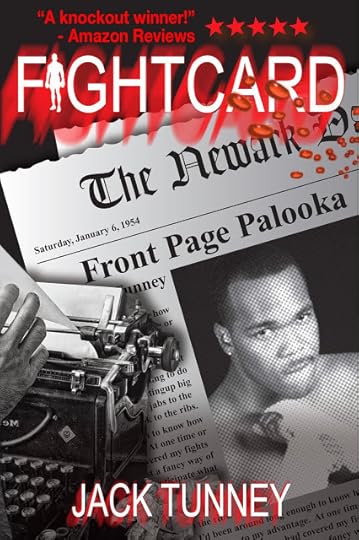 FIGHT CARD UPDATE!
FIGHT CARD UPDATE!After the highly successful launch of last month’s Fight Card Romance: Ladies Night, we have a wonderful follow-up this month with the debut of Fight Card: Front Page Palooka from the dynamic Anthony Venutolo.
When he’s not hanging with his family, or chronicling the antics of Boardwalk Empire for the Star Ledger, the New Jersey based Ant-maninhabits Bukowski's Basement (http://tinyurl.com/q294tyh), a blog dedicated to the Skid Row poet and all things flash fiction.
In Front Page Palooka, Ant gives us the Bogey inspired newshound, Nick Moretti – charming, yet cynical, burned-out, whiskey-sodden, and not above making sure the right hand doesn’t know what the left hand is doing. Front Page Palooka has it all ... dames, dives, and hard-punching attitude.
FRONT PAGE PALOOKA
Newark, New Jersey, 1954
Years of fight halls and newsrooms have east coast sportswriter, Nick Moretti, looking for a change. When a sloppy hustle goes bad, and Nick takes a bullet in the shoulder, it’s time to go west. Hired by Pinnacle Pictures to write a boxing movie about troubled heavyweight champ Jericho ‘Rattlesnake’ McNeal, Nick joins forces with sexy public relations gal, Dillian Dawson, for a cross-country tour to give an everyman boxer an unlikely shot at the world title – what could go wrong?
From the crackling neon of Hollywood and Sin City, through the steamy Delta, and on to Chi-Town, the glitzy dream becomes a noir nightmare, and newshound Nick Moretti is about to commit a reporter’s greatest sin – becoming a Front Page Palooka ... Another great two-fisted Fight Card tale!
As usual, we appreciate any and all blog shout-outs, mentions on social networking sites, and Amazon reviews.
Next in the ring, we have Fight Card: Swamp Walloper – featuring the return of Patrick FelonyFlynn in the long awaited (at least by me) sequel to Felony Fists – along with Punching Paradise from Nik Korpon, and Fight River from Tommy Hancock.
Andrew Salmon has been time travelling back to Victorian, England, as he’s been completing our highly anticipated December offering for the holidays, Fight Card: Sherlock Holmes – featuring a stunning painted cover from artist (and new Fight Card team member) Carl Yonder (illustrator of the hardboiled skull and crossbones comic, Pirate Eye (tinyurl.com/nncquoe).
A big thanks this month to Fight Card Team member Jeremy L.C. Jones for his efforts on getting many of our publicity posts out into the wider blogoverse via Book Life Now (tinyurl.com/qax5vlr) with upcoming coverage via Venture Galleries. Jeremy is also the power behind lining up the numerous fantastic authors contributing stories to three upcoming Fight Card short story anthologies – the proceeds from which will go to authors in need and other literary charities.
Despite his own busy work schedule, David Foster has continued to produce Fight Card covers not only for our e-book releases, but also for the paperback versions (along with beautifully tweaking my efforts at .pdf interior files). Thx, buddy, we couldn’t do this without you.
I’d also like to welcome writer Kathleen Rice Adams into the Fight Card fold (www.kathleenriceadams.com). Kathleen is an accomplished writer who will be handling the next book in our hybrid Fight Card Romance spin-off, and we’re very much looking forward to her take on Love On The Ropes ...
More next month on our upcoming Fight Card audio versions from Dynamic Ram ...
Till then, keep punching ...
Published on October 04, 2013 22:43
October 3, 2013
NOW AVAILABLE IN PAPERBACK
 NOW AVAILABLE IN PAPERBACK!
NOW AVAILABLE IN PAPERBACK!FIGHT CARD: BAREFOOT BONES
BOBBY NASH
FIGHT CARD: BAREFOOT BONES
Korea, 1951
Mentored in the hollows of hardscrabble Georgia by mysterious loner Old Man Winter, then in a Chicago orphanage by ex-fighter Father Tim Brophy, James ‘Barefoot Bones’ Mason has relied on his fists to make his way. But it’s a long way from St. Vincent’s Asylum For Boys to the battlefields of Korea where Bones’ fists may not be enough.
Entered in an inter-camp boxing tournament by his commanding officer, Bones finds himself in a war within a war. When a tenuous cease fire is explosively shattered, Bone’s is fighting against the highest odds of all – staying alive. Can a skinny kid from the north Georgia mountains survive the hell of Korea and still have the guts to climb back into the ring one more time?
The one constant in Bones’ life has been fighting – Lucky for him… he’s good at it.
Published on October 03, 2013 14:48

